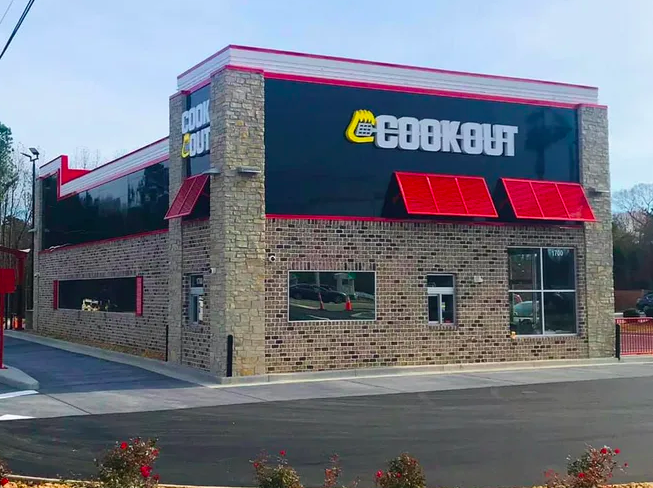Raising Cane’s Chicken Fingers, commonly known as Raising Cane’s, is a fast-food restaurant chain specializing in chicken finger meals. This chain was established back in August 28, 1996 in Baton Rouge, Louisiana, by Todd Graves and Craig Silvey. Currently, Raising Cane has branches in over half of the 50 United States, including Ohio and Texas.
How much does it cost to open a franchise of Raising Cane’s? According to the companies official website, Raising Cane’s is not accepting new franchise or development opportunities. Instead the company focuses on developing corporate stores and supporting current franchise partners with no intentions to franchise new locations in the immediate future. Raising Cane’s only has six franchise partners who collectively operate 90 franchise locations. You can take our 7-minute franchise quiz to find out if Raising Cane’s is right for you.
Even though you can’t franchise this restaurant right now, I will still be evaluating Raising Cane’s sales, revenue, and other business information. In this way, you’ll be prepared to act if the company decides to open up franchise opportunities again in the future. Come join me and take a closer look at this growing chicken-finger meal business that I personally find delicious.
Page Contents
- Financial Requirements and Fees
- Average Sales / Revenue Per Year
- Raising Cane’s Franchise Facts
- How Much Profit Per Year?
- Advantages of Franchising Raising Cane’s
- Simple Menu
- Training and Financing
- Quality Company
- Challenges of Franchising Raising Cane’s
- Slower Rate of Outlet Growth
- High Financial Requirement
- Currently Not Accepting Any Franchise
- Is the Raising Cane’s Franchise Right For You?
- What is an alternative Raising Cane’s franchise?
Financial Requirements and Fees
The first question a franchisee will want to know is how much a Raising Cane’s franchise is going to cost? The financial requirements and costs for a Raising Cane’s franchise are listed below as a rough estimate based on similar concepts. But first, let me explain some of the financial terms I’ll reference in this section.
- Liquid capital refers to the entire amount of cash you will need on hand and is available to use at any time.
- Net worth refers to the value of all your non-financial and financial assets minus the value of all your outstanding liabilities.
- Total investment is the total capital or the total money you will need to put into the franchise overtime to get it up and running.
- Lastly, franchise fee refers to the amount you must pay to the franchisor to use its brand and resources.
| Fees or Expenses | Financial Amount |
| Liquid Capital | $500,000 |
| Net Worth | More than $1 million |
| Total Investment | $1,000,000 – $1,937,500 |
| Franchise Fee | $45,000 (Previous Fee) |
To be clear, this is a ball-park estimate of what it could cost to open a Raising Cane’s in the event they allow franchisees to join their team in the future.
Bear in mind before deciding on a franchise opportunity, you should carefully consider the whole cost of the business. Some franchise opportunities may offer you low franchise fees, but have significant ongoing costs such as training fees, technology fees, payroll fees and many others.
Initially, the potential franchisee must obtain a Raising Cane’s license because without this, the name, logo, and goods of Raising Cane will be off-limits. Before the company paused accepting new franchisees, the cost of their license fee was $45,000. This expense is in-line with other restaurant franchises.
Franchise Review: What’s the Real Cost to Open a Checkers and Rally’s?
There are numerous fees associated with starting a new restaurant after obtaining the license. I estimated that the launch expenditures for a new Raising Cane’s will range between $768,000 to $1,938,000.
For the first three months of operation, these costs will cover items like space rental, equipment purchases, staffing, and inventory stock. You will also require a working capital range of $90,000 to $250,000 and a net worth of more than $768,000 to acquire this business.
Bottom line, no matter what franchise opportunity you decide to apply for, you need to start saving liquid capital and get your personal finances ready to meet or exceed the financial requirements.
Average Sales / Revenue Per Year
One of the most frequently asked topics by potential franchisees is the revenue or amount of income that can be earned, which is understandable given that everyone wants to make a return on their time and money investments.
Raising Cane’s USA’s most updated revenue is $3.3 billion and the company employs over 50,000 people. This is a massive number of chicken wings being sold.
Not Sure What Franchise to Start? Take Our 7-Minute Franchise Business Quiz!
Keep in mind that revenue is not the same as profit. There are many fixed expenses that go into the operation of a restaurant. What exactly are these expenses? Among other things, they include commercial lease rates, local demand for your goods, food and labor costs. Lease rates, for example, will influence your entire profit. On top of that, larger investments should result in higher earnings too.
Raising Cane’s Franchise Facts
| Total Units: | 700 |
| Incorporated Name: | Raising Cane’s Restaurants, LLC |
| Franchising Since: | 1996 |
| Industry: | Fast-food restaurant chain |
| Subsector: | Restaurants |
Todd Graves and Craig Silvey founded Raising Cane’s, a fast-food restaurant business specializing in chicken fingers in Baton Rouge, Louisiana in 1996. Graves, a University of Georgia student, and Silvey, an LSU student, were both enrolled in a business plan writing class. Graves wrote the business plan, which Silvey submitted and scored a C- minus for.
Silvey’s professor, were not unimpressed with the concept. After being unable to find funding, Graves chose to earn the needed money himself. After saving for a few years, the two entrepreneurs were able to acquire an SBA loan and build their first restaurant in Baton Rouge, near the LSU campus, in 1996.
Raising Cane’s discovered the ideal niche for their particular business model and served a limited menu. They aim to serve exceptionally high-quality products quickly and conveniently through the means of offering only a short and limited menu. Recently, Raising Cane’s was placed No.29 in both Nation’s Restaurant News and Restaurant Business Online’s Top 500.
Raising Cane’s outlets have proven to be resilient even during government mandated lockdowns that hurt other restaurants. Converted from dine-in to pick-up and take-out service in March 2020, while others closed temporarily. In 2022, Raising Cane’s opened 79 units which led to a 13.9% growth and an 11.2% estimated sales per unit.
How Much Profit Per Year?
It is important to understand that your profitability as a franchisee of Raising Cane’s is influenced by a number of factors. Commercial lease costs in your location, local product demand, labor costs, and how well you manage your operations are all factors to consider.
Some locations have more expensive lease rates than others. As a result, franchisees in areas with lower lease rates tend to spend less on a lease, making them more profitable than those in areas with higher lease rates.
According to Fin Models Lab, one Raising Cane’s location in Baton Rouge has an annual revenue of $5.5 million with a 20% profit margin. But do keep in mind that not all locations generate the same amount of revenue and has the exact profit margin.
Advantages of Franchising Raising Cane’s

Raising Cane’s chicken fingers meal with a side of toast.
There is a lot to consider before pushing forward with your plans to franchise this business. Like most businesses, owning a Raising Cane’s franchise has advantages and downsides. I’ve highlighted the benefits right here to help you make a more informed decision. Keep reading to learn more about some of the benefits.
Simple Menu
Raising Cane’s menu is as straightforward as it gets: chicken fingers, fries, coleslaw, Texas Toast, and the unique Cane’s sauce. That’s it! You may wonder, how is it an advantage? Truth is, customers are more likely to recall why they visit a certain restaurant when the menu is shorter. Diners will remember a restaurant’s specialty cuisine, but they will quickly forget the five-page menu. Nowadays, many restaurants are attempting to establish themselves based on quality rather than the breadth of their menus.
As a matter of fact, one of the themes of Gordon Ramsay’s famous Fox TV show “24 Hours to Hell and Back” is an overhaul of a struggling restaurant’s menu. Without a doubt, every episode entails minimizing the menu. Ramsay often cuts the number of dishes by more than two-thirds, then he teaches their cooks a few culinary methods in order to maximize the quality of their newly limited menu.
Training and Financing
Raising Cane’s franchise provides various advantages to its franchisees. These are intended to improve the franchisee’s chances of success. Franchisees are given training to help them get off to a good start. There is hands-on training as well as classroom training available wherever the franchisee chooses.
On top of that, they offer another advantage to its franchisees in the form of financing. Typically, financing covers a variety of expenses, such as the franchise fee and veteran discounts, among others. Although Raising Cane’s provides franchisees with financing advantages, it does not disclose what form of financing they receive. You’ll have to find out by speaking with customer service after you’ve been approached for additional discussions.
Quality Company
Raising Cane’s average unit volumes (AUVs) are close to $3.6 million. In comparison, McDonald’s pulls in about $2.8 million in AUVs. This expansion could be attributed to a number of things.
It is said that it could be attributed to Raising Cane’s simple menu that is as straightforward as it gets: chicken fingers, fries, coleslaw, Texas Toast, and the distinctive Cane’s sauce. That’s all there is to it.
Franchise Review: How Much Will It Cost to Open a Dickey’s Barbecue Pit?
Challenges of Franchising Raising Cane’s
Together with the benefits of owning a Raising Cane’s franchise, there are certain disadvantages to consider, and it is vital to investigate these issues before franchising. To assist you in making a better decision, I highlight some of the challenges you may experience as a Raising Cane’s franchise owner.
Slower Rate of Outlet Growth
An indicator we can rely on to know whether a company is worth franchising or not is the Net Franchise Growth Rate. This will tell you of the number of franchises that are opening versus those that are closing. If the brand is experiencing more closures than openings, it is reasonable to assume that there are issues with the brand.
Raising Cane’s Net Franchise Growth Rate is positive at 31. However, it is much lower than the average rate of 97. This is not always suggestive of a bad system but rather of a slower rate of growth.
When assessing any franchise company, it is critical to analyze the system’s rate of growth. You want to ensure that the franchise has the long-term viability that comes with significant growth but that it isn’t growing too quickly to manage the difficulties that come with it.
High Financial Requirement
Another thing to call out is their high franchise fee. The cost of their franchise is a bit more expensive in comparison to others with a better track record. Before obtaining a license with Raising Cane’s, or any other franchise for that matter, it is highly recommended that you examine all of the advantages and downsides.
To franchise Raising Cane’s, expect that you will have a franchise fee of $45,000 and a total investment cost of $768,100 to $1,937,500. In contrast, Popeyes Louisiana Kitchen, which is one of their closest competitors, only has a franchise fee of $30,000 and a total investment of $500,000 – $1,000,000.
Currently Not Accepting Any Franchise
At the time of writing, you still can’t start a franchise with Raising Cane’s. If this changes in the future, we will be the first to let you know. I believe this is a fantastic company with a bright future. Even though I can’t be an owner, I will continue to be a customer.
Is the Raising Cane’s Franchise Right For You?
For anyone interested in starting a Raising Cane’s franchise, knowing what it takes to get started is never a bad idea even though they are not selling new licenses as of this moment. If Raising Cane’s permits new franchisees to join the industry, it could be a fantastic opportunity since they have the potential to be a big success in the United States and around the world.
It’s important to choose a license with a company that will work with you to achieve success. Doing your homework could mean the difference between your franchise’s success and failure.
What is an alternative Raising Cane’s franchise?
If you can’t wait for Raising Cane’s to reopen for franchising, you can try Bojangles’ International or Church’s Chicken. Both restaurants serve similar menu items as Raising Cane’s. The franchise cost for Bojangles’ International is $35,000, whereas the fee for Church’s Chicken is $15,000.





